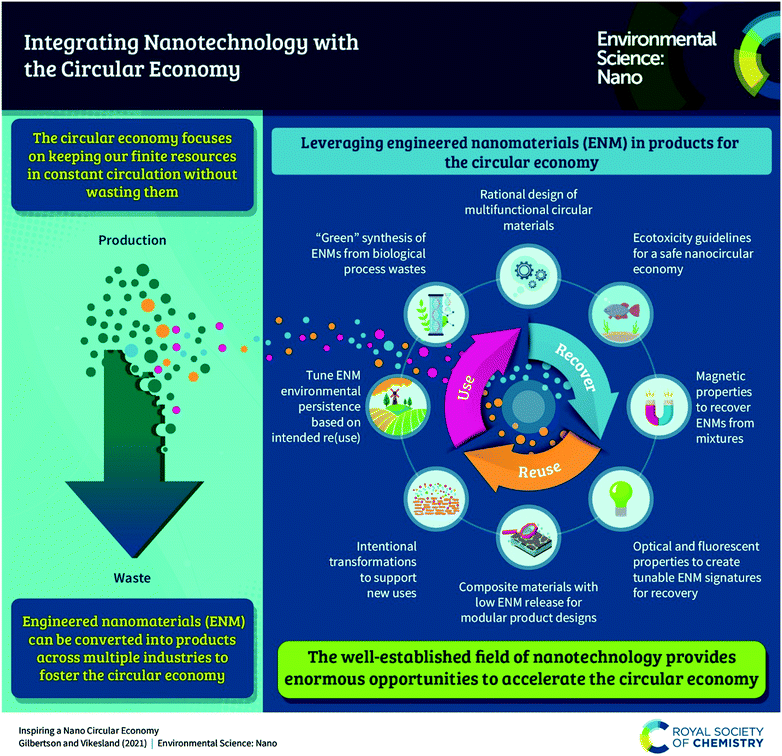Inspiring a nanocircular economy
Leanne M.
Gilbertson
 *ab and
Peter J.
Vikesland
*ab and
Peter J.
Vikesland
 *c
*c
aDepartment of Civil and Environmental Engineering, University of Pittsburgh, USA. E-mail: leanne.gilbertson@pitt.edu
bDepartment of Chemical and Petroleum Engineering, University of Pittsburgh, USA
cDepartment of Civil and Environmental Engineering, Virginia Tech, USA. E-mail: pvikes@vt.edu
Abstract
Editorial on the nanocircular economy by Editorial Board member Leanne Gilbertson and Editor-in-Chief Peter Vikesland.
The circular economy is a sustainable design framework that shifts our product ecosystem (i.e., the generation and use of resources) from the conventional, “take-make-waste” linear model to one that is circular. The interconnections between global prosperity and our finite resources are central to this regenerative model, with the goal of keeping resources in circulation, never producing waste. Biological resources are generated, consumed, and are maintained within a biological cycle and finite resources that enter the technical cycle are extracted, used, recovered, and reused or upcycled.†
The circular economy is not a concept or aspirational goal, it is a reality. From the way food is produced to how our clothes are made, our product ecosystem is changing through societal adoption of circular economy principles.† Similarly, nanotechnology is no longer a novel, emerging field. Engineered nanomaterials (ENMs) are incorporated in products across all major markets. Thus, there is an opportunity to accelerate the circular economy by establishing connections between the past, present, and future of environmental nanotechnology research. For ENMs to integrate with the circular economy, we must continue innovating with regards to how they are generated and how they are leveraged in products that are designed in the circular economy framework.
The concepts underlying the circular economy are not new to our community. In fact, we spent the past two decades considering the interactions of ENMs with natural systems and their incorporation into new technologies and products. Through this research, we uncovered how ENM properties, behaviors, and functions as well as the products they enable, are modified in natural and engineered systems. While much of this work was initially pursued and discovered through the lens of risk assessment and safety, the findings from our historic and continued efforts will ensure that the future of “the very small” fosters the circular economy rather than becoming obsolete or forgotten in its wake.
The nanocircular economy
In the circular economy, materials exist in biological or technical cycles. The biological cycle is composed of materials from renewable resources that, at the end of your useful lifetime, nourish and perpetuate as natural, biochemical feedstocks. Materials in the technical cycle are sourced from finite resources that have no conventional end-of-life; they are reused in the same or another product in their current or a transformed form. Environmental nanotechnology research to date illuminates immense synergies with the circular economy in several key areas, providing opportunities to accelerate its success (Fig. 1).You might be asking, where should I begin? The answer is simultaneously satisfying and intimidating because you can start, literally, anywhere. The salad you just ate, the shirt on your back, the screen you are looking at, the transportation you used to get to work today are all part of the circular economy. The conversation has started, look around you and let's innovate, let's shift our lens, and let's inspire the nanocircular economy.
Footnote |
| † https://ellenmacarthurfoundation.org/topics/circular-economy-introduction/overview. |
| This journal is © The Royal Society of Chemistry 2022 |

